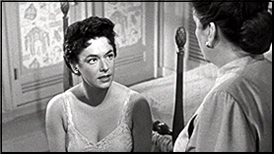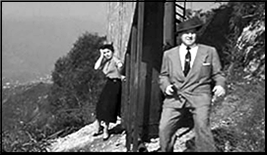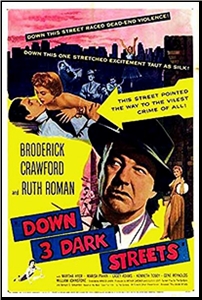Tue 19 Jun 2018
A Movie Review by Jonathan Lewis: DOWN THREE DARK STREETS (1954).
Posted by Steve under Crime Films , Reviews[11] Comments

DOWN THREE DARK STREETS. United Artists, 1954. Broderick Crawford, Ruth Roman, Martha Hyer, Marisa Pavan, Max Showalter (as Casey Adams), Kenneth Tobey. Screenplay by Bernard C. Schoenfeld and The Gordons (Gordon & Mildred), based on the latter’s novel Case File: FBI. Director: Arnold Laven.
If you can get past the grating voice-over narration designed to constantly remind you that the brave men of the FBI fight crime like this every day, Down Three Dark Streets is an enjoyable, if somewhat ordinary, crime docudrama. Directed by Arnold Laven, who is perhaps known more for his work in television, this lesser known film noir features Broderick Crawford as FBI Agent John Ripley of the Los Angeles field office. His task is to solve what appears at first to be three completely unrelated crimes: a wanted criminal on the lam; an extortion plot targeting a widow by the name of Kate Martell (Ruth Roman) and her young daughter; and an auto theft ring.

When Ripley’s partner is gunned down while following up on a lead on one of the cases, the stakes are raised. Now it’s not just business. It’s personal. Or so that’s what’s the impression I think the viewer is supposed to get. Oddly, though, you never really get a sense of Ripley’s personality, let alone his personal life. Crawford portrays him as somewhat monkish, if also tough and jaded. Perhaps this was by design, with the filmmakers wanting to show the FBI as an organization so devoted to the job of protecting the public that their agents don’t have time or the luxury of families and friends.

What makes Down Three Dark Streets worth a look, though, is in its hardboiled dialogue and its cast. There are some fine character actors here. Max Showalter portrays a sleazy real estate agent living beyond his means; Claude Akins takes the role of a boxer and an underworld enforcer; and Jacob Adler (brother of Luther and Stella) is well cast as the deadbeat uncle living with Kate Martell (Roman).
And last, but by no means least, is the final sequence, a showdown filmed on location under the W of the Hollywood sign. It’s a great, albeit little known, moment in crime film history, with dollar bills blowing in the wind through the Hollywood Hills.

June 19th, 2018 at 8:29 pm
Crawford strikes again.
June 19th, 2018 at 10:14 pm
I wondered how many people would notice. Or if anyone would!
June 19th, 2018 at 9:53 pm
Mildred Gordon and her husband Gordon Gordon (really – look it up) wrote a number of novels about FBI Special Agent John Ripley.
One of the later ones became the film Experiment In Terror; Agent Ripley was played by Glenn Ford.
*Believe It Or Not!*
(Sorry – couldn’t resist …)
June 19th, 2018 at 10:17 pm
That’s OK, Mike. We all understand. I wouldn’t have either, if I’d thought of it first. Resist, that is.
The Gordons also wrote a series of books about D. C. Randall, who is an “undercover cat.” One of them as made into a movie by Disney.
June 19th, 2018 at 10:19 pm
All seriousness aside, that bottom image from the movie really suggests that the ending is a humdinger of one.
June 19th, 2018 at 10:35 pm
I enjoyed this film. And also another procedural directed Arnold Laven, “Vice Squad” with Edward G. Robinson. Much of Laven’s TV work is also good.
He was also important as a producer, doing The Rifleman and The Big Valley.
June 19th, 2018 at 11:32 pm
I thought 3 Dark Streets a pretty good picture made better by Broderick Crawford. I think he played with plenty of personality and clearly liked, in more than one way, the Roman character. It was a warm movie star performance.
June 20th, 2018 at 10:15 am
Side Note:
Has it occurred to any of you out there that one of Broderick Crawford’s later film performances was as J. Edgar Hoover, in Larry Cohen’s The Private Files Of …?
This is a “backdoor” favorite of mine – sort of the Mad, Mad, Mad, Mad World of conspiracy movies: All-Star cast of historical figures, myths brought to life, big “twists” that you can see coming a mile away, and stuff like that there.
My fave: the implication that “Deep Throat” was really Hoover’s pal Clyde Tolson (played here by a paunchy, balding Dan Dailey), who sums up the proceedings with a kind of reverse “Jesus speech” about what’s to come.
And not long after that, there was Brod Crawford’s now-legendary host stint on Saturday Night Live.
See it if you can – and then read the accounts of how he approached the Hoover sketch that ended the show.
There’s a lot to say about reaching a point in your life where you just don’t give a damn any more …
June 20th, 2018 at 11:22 am
I haven’t been able to find a free video of the show, but perhaps someone else can. The best I could do is something called Hulu, but it looks as though you have to register to be able to see anything there. (There may be a fee.)
Here are links to a couple of web posts talking about the episode:
https://hotoffpress.wordpress.com/2010/09/22/snl-crawford-meters-allstars/
https://stevenpressfield.com/2012/01/george-peper-bill-murray-and-broderick-crawford/
Date: March 19, 1977.
June 20th, 2018 at 5:16 pm
Steve, a fun story about Brod and Saturday Night…and I believe every word of it.
June 23rd, 2018 at 8:15 pm
Crawford is good here, but an odd choice for Ripley who is the ultimate clean cut FBI agent. Glenn Ford was much closer in EXPERIMENT IN TERROR.
I’m a fan of the Gordons, both the early books with Mildred and the later ones with his second wife. They wrote some excellent stand-alones as well as series books and one mainstream political thriller.